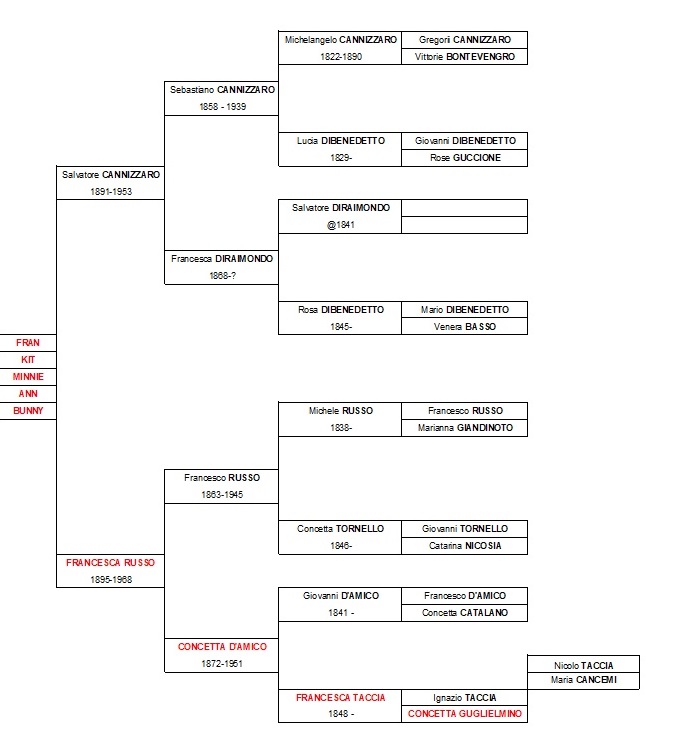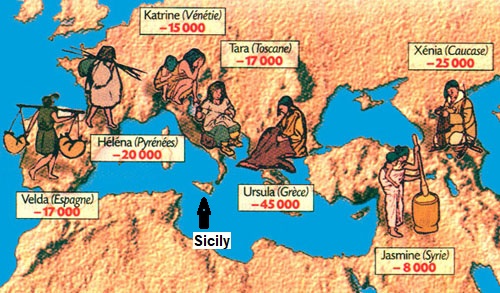Cannizzaro Family Chart
Cannizzaro Family History
Cemeteries
Causes of Death
Photos
Documents
Family Recipes
DNA Testing
Email Me
DNA Testing

It is very difficult to go beyond this timeline because very few, if any, civil records exist before 1820 in Sicily. To go further back, I would have to find church records that recorded births, marriages and deaths. Dealing with the church, especially in Italy, for such ancient information is daunting, if not impossible.
There is, however, another method: DNA testing. We all have DNA in the cells of our bodies that we inherit from our parents, but only males have the nuclear DNA, called ychromosome or yDNA, that is passed only from father to son. I inherited my yDNA from my father, Eugene Lanzaro, who got it from his father, Ciro Lanzaro, who got it from his father, Giuseppe Lanzaro, etc. Theoretically, we could trace my Lanzaro surname by comparing my yDNA with my father's, my grandfather's, my ... ...wait a minute. For this to work, I would have to have my yDNA compared to that of someone who is no longer alive. This just isn't possible.
But wait another minute! There is another form of DNA called mitochondrial DNA, or mtDNA for short. The mtDNA is passed from a mother to all of her children, male and female, but only females can pass it to their children. My sister Jeanne and I both have the mtDNA that we inherited from our mother Ann, but only Jeanne can (and did) pass it on to her children, Vanessa and Victoria. It wouldn't matter if I had children. As a male, I can't pass my mtDNA to any of my children.
Ann, and Frances, and Kit, and Minnie, and Bunny all inherited the same mtDNA from their mother, Francesca Russo. She inherited it from her mother, Concetta D'Amico. Concetta got it from her mother, Francesca Taccia. Francesca got it from her mother, Concetta Guglielmino. Obviously, our ancestors did not have a great deal of imagination when it came to naming their daughters.
Now, this is as far as I can go with names because my research, based on written documents, ends here. But obviously, Concetta Guglielmino inherited her mtDNA from her mother, who got it from her mother, and on and on and on, back through time to.. ..? Eve? Theoretically, yes.
Our mtDNA traces an unbroken maternal line back through time for generation upon generation far further back than any written record. So what? How does this help us trace our family tree back any further than I already have? The answer is, it doesn't, and it does.
Geneticists have been studying mtDNA for several decades. They have been taking samples from people in Europe, the Middle East, Russia, North America and South America. What they have discovered is that nearly everyone in these areas have only 7 unique types of mtDNA. That means that most people alive today can trace their mtDNA back through time to just 7 women, the so-called Seven Daughters of Eve.
To emphasize that they were real individuals, the geneticists have given them all names and, using archaeological and other evidence, have reconstructed their imagined lives. Note that none of them are named Francesca or Concetta.

The clan of Ursula (Latin for she-bear) is the oldest of the seven native European clans. It was founded around 45,000 years ago by the first modern humans, Homo Sapiens, as they established themselves in Europe. Today, about 11% of modem Europeans are the direct maternal descendants of Ursula. They come from all parts of Europe, but the clan is particularly well represented in western Britain and Scandinavia.
The clan of Xenia (Greek for hospitable) is the second oldest of the seven native European clans. It was founded 25,000 years ago by the second wave of modern humans, Homo Sapiens, who established themselves in Europe, just prior to the coldest part of the last Ice Age. Today around 7% of native Europeans are in the clan of Xenia. Within the clan, three distinct branches fan out over Europe. One is still largely confined to Eastern Europe while the other two have spread further to the West into central Europe and as far as France and Britain. About 1% of Native Americans are also in the clan of Xenia.
The clan of Helena (Greek for light) is by far the largest and most successful of the seven native clans with 41% of Europeans belonging to one of its many branches. It began 20,000 years ago with the birth of Helena somewhere in the valleys of the Dordogne and the Vezere, in south-central France. The clan is widespread throughout all parts of Europe, but reaches its highest frequency among the Basque people of northern Spain and southern France.
The clan of Velda (Scandinavian for ruler) is the smallest of the seven clans containing only about 4% of native Europeans. Velda lived 17,000 years ago in the limestone hills of Cantabria in northwest Spain. Her descendants are found nowadays mainly in western and northern Europe and are surprisingly frequent among the Saami people of Finland and Northern Norway.
The clan of Tara (Gaelic for rocky hill) includes slightly fewer than 10% of modern Europeans. Its many branches are widely distributed throughout southern and western Europe with particularly high concentrations in Ireland and the west of Britain. Tara herself lived 17,000 years ago in the northwest of Italy among the hills of Tuscany and along the estuary of the river Arno.
The clan of Katrine (Greek for pure) is a medium sized clan with 10% of Europeans among its membership. Katrine herself lived 15,000 years ago in the wooded plains of northeast Italy, now flooded by the Adriatic, and among the southern foothills of the Alps. Her descendants are still there in numbers, but have also spread throughout central and northern Europe.
The clan of Jasmine (Persian for flower) is the second largest of the seven European clans after Helena and is the only one to have its origins outside Europe. Jasmine and her descendants, who now make up 12% of Europeans, were among the first farmers and brought the agricultural revolution to Europe from the Middle East around 8,500 years ago.
The clan mothers were not the only people alive at the time, of course, but they were the only ones to have direct maternal descendants living right through to the present day. The other women around, or their descendants, either had no children at all or had only sons, who could not pass on their mtDNA. And, of course, the clan mothers had ancestors themselves. Amazingly, their genealogies have also been discovered. They show how everyone alive on the planet today can trace their maternal ancestry back to just one woman. By all accounts, she lived in Africa about 150,000 - 200,000 years ago and is known as "Mitochondrial Eve".
But, let's get to the real reason for all this. I had my mtDNA tested! I know which of the 7 daughters of Eve we are descended from!! can you guess who it is?
Is it Tara or Katrine, who originated from northern Italy?
Is it Ursula, the oldest clan mother?
Is it Helena from whom the largest group is descended? Could we be that common? Of course not! We're unique! (and Spanish?).
Have you guessed it? The answer is here.